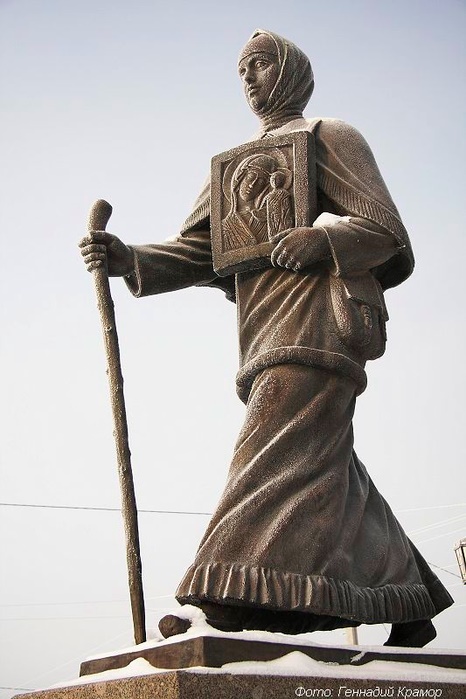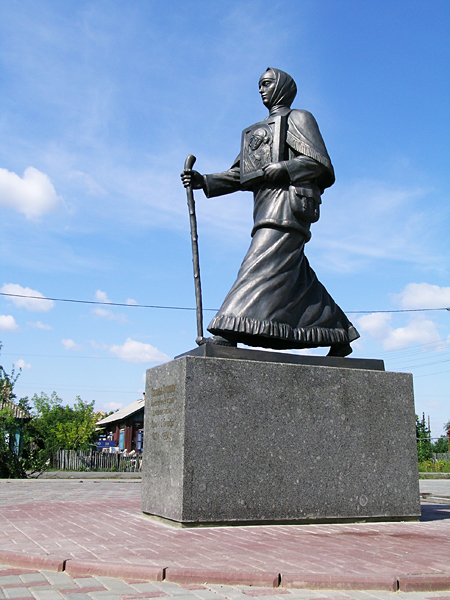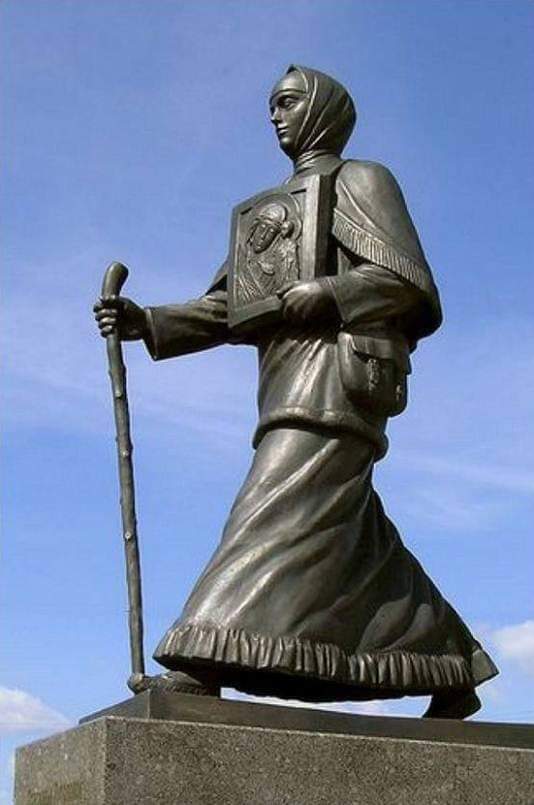Snowmaiden Praskovya Lupolova monument

Snowmaiden Praskovya Lupolova monument
In honor of the girl, who passed more than four thousand miles to save her father, writers wrote novels and composers composed operas. The fairytale character has real roots – all of Europe admired a girl from the snowy Siberia two centuries ago. And now she returned – already in bronze. In the Siberian city of Ishim, from where Parasha began her journey to St. Petersburg, a monument was erected near the temple. And the local puppet theater these days shows the New Year’s play “The Girl and the Tsar” after the tale of Yuri Kharlamov, based on the fate of a brave girl.
Imagine how much courage she needed to walk through the taiga in the cold. Wolves, robbers, hunger and cold – Parasha experienced everything to rescue her beloved father. He was a hussar officer, a nobleman, exiled to Siberia for evil libel. The wife and daughter went to Siberian Ishim after him. And then Parasha went to the capital of the empire, hoping to soften the fate of her father. In the passport issued by the girl recorded “captain’s daughter.” Later, Pushkin made her the prototype of his heroine, Masha Mironova in his novel “Captain’s Daughter”. Remember – in the story the heroine saved the groom by throwing herself at the queen’s feet …

Out of the darkness of oblivion, Parasha returned thanks to Tatyana Savchenkova, an associate professor of the Ishim Pedagogical Institute. She was the first to find references to this girl in the archives. In particular, she found old books and magazines dedicated to her. And was amazed – it turned out that Praskovya Lupolova was a star that inspired many European writers and musicians!

Frenchwoman Sophie Cottin published the novel “Elisabeth ou Les exiles de Siberie (1806), and it immediately became a bestseller, translated into 80 languages! And a Russian-born Frenchman, Xavier de Maistre, a relative of Alexander Pushkin’s wife, wrote the story “Young Siberian”.


Italian composer Gaetano Donizetti created the opera “Eight Months in Two Hours, or Exiles in Siberia” – so popular that the melody from it became an anthem of the Garibaldi rebels. Besides, his compatriot Gaetano Joya staged the Siberian Exiles ballet. In Russia, the play “Parasha-Siberian” written by Nikolai Polevoi, took place in the imperial Alexandria theater. All Russian and European authors who turned to the adventures of Parasha can’t be counted …

Siberians raised money for the monument to Praskovya. Russian sculptor Vyacheslav Klykov worked on the monument already mortally ill, knowing about his incurable illness. The sculptor explained his creative impulse as follows:
– I thought, could my daughter make such a feat? To pass half of Russia, taking with her only an icon and a stick, to achieve an audience with the king! Such feats happen once a century – in order to set an example for everyone how to love their parents. This feat is worthy of all-Russian and all-church recognition …
The inscription on the pedestal reads: “To Praskovya Lupolova, who showed the world the feat of a daughter love”

However, the real fate of Parasha is more dramatic than all the novels written about her. Praskovya Lupolova was born in 1784 in the family of Ensign Grigori Lupolov, a participant in the assault of Ishmael and Ochakov. In 1789 he was accused of buying allegedly stolen horses for his hussar regiment, deprived of officials and nobility, he was exiled to Ishim. The family was in poverty, hungry, the father fell ill – and then in September 1803 Praskovya Lupolova went to Petersburg to ask the king for mercy. She took with her only a silver ruble, an icon of the Virgin Mary and a parental blessing. Walking on foot, conquering fear, comforting herself with the words: “God is alive, my soul is alive!”

In the spring along the river the girl reached Vyatka, nearly drowned, falling from a boat, then walked to Kazan, and from there she reached Moscow. And on August 5, 1804, having been in travel for almost a year, reached the capital. There, having endured humiliation and tribulations, she was finally able to get into the palace. At first she told the Empress about her misfortune, and she helped to petition Alexander I.

The girl touched the king’s soul in her own words: “Parents are always innocent in the eyes of children!” The emperor ordered to return her father from exile. Noteworthy, he gave the girl a huge pension for that time from the treasury. Also, newspapers and magazines excitedly wrote about the brave beauty from Siberia, and she became an enviable bride. Obsessed with power, rich, famous – even by today’s girl’s standards, this is the pinnacle of happiness …

However, Praskovya preferred monasticism to successful marriage and bright life at the royal court. She explained to her parents that she had vowed to take the veil on the way. In November 1809, the girl died in the Desiatinny Monastery in Veliky Novgorod from consumption – she was only 25 years old! Buried in the basement of the church of the monastery, her monastic name “Elizabeth” was carved on the tombstone.

There is information that Empress Alexandra Feodorovna, the wife of the last emperor Nicholas II, came to Praskovia’s grave a hundred years later and prayed like to a saint.

The Orthodox Church is now preparing materials for the canonization of Praskovya Lupolova. Her relics have not yet been found, and the portraits have not been preserved, although according to her contemporaries, artists depicted her face many times. In particular, the famous Russian painter Mikhail Nesterov, inspired by the history of Praskovya, he painted “Great tonsure” in 1898. On it she is beautiful in face and spirit. Sculptor Vyacheslav Klykov depicted Parasha aspiring forward, she walks to us through the centuries to teach true love.
Snowmaiden Praskovya Lupolova monument



sources
vk.com/sculptor_vyacheslav_klykov
Archive of Russian House magazine, №10 october 2009
www.trud.ru/article/24-03-2004/69561_peshkom_iz_sibiri.html
wikipedia.org







